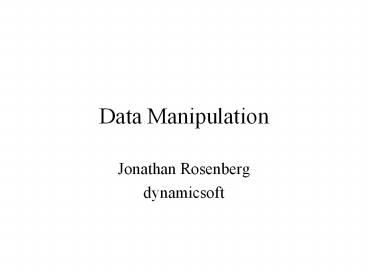Data%20Manipulation - PowerPoint PPT Presentation
Title:
Data%20Manipulation
Description:
Hierarchical tree of name/value pairs. Server doesn't care about the meanings of the names or values ... ACAP Dataset Class on what the names and values mean ... – PowerPoint PPT presentation
Number of Views:59
Avg rating:3.0/5.0
Title: Data%20Manipulation
1
Data Manipulation
- Jonathan Rosenberg
- dynamicsoft
2
Where are we
- Problem Statement
- Manipulate buddy lists (create, list, add,
delete) - Manipulate authorization policy (black/white
lists, per-attribute permissions, etc.) - Captured in draft-ietf-simple-data-req
- Big idea
- These are just examples of application data
manipulation - Use a generic mechanism
- ACAP is close
3
What is ACAP?
- Application Configuration Access Protocol,
RFC2244 (Issued November 1997) - Target application
- Server-based storage and client access to web
browser address books and bookmarks - Goal Generic mechanisms for application-independe
nt access to per-user application configuration
data from multiple clients
4
ACAP Quick Summary
- Protocol operates much like IMAP in its syntax
and message flow - Client/Server
- Text-based
- SASL for security
- Based on the ACAP Data Model
- Hierarchical tree of name/value pairs
- Server doesnt care about the meanings of the
names or values - Each usage defines a convention ACAP Dataset
Class on what the names and values mean - Only the clients care about this (usually)
5
ACAP Key Concepts
- Access Controls are Built In
- Each attribute has an acl which defines what
users can do with it - Inheritance
- One part of the tree can inherit from another
- But can make local modifications that are not
reflected in the parent - Usage department wide buddy lists
- ACAP URL points to a tree locally or on another
server - Synchronization
- Multiple clients can access the data
- Versioning for collision detection, notifications
to indicate if it changes under you
6
ACAP Primitives
- Searching
- Boolean expressions on attributes
- Can limit number of responses, response
pagination, sorting of response, list specific
attributes to return - STORE command
- Create, modify, delete entries
- Can be conditioned on a version number
- Can set multiple attributes at once
- Rights Management
- Can set and delete ACLS
- Can query for permissions visible to themselves
- Quotas
- Maximum amount of data per user
7
The Presence List
- Each entry in the tree is either another list or
a presentity - A presentity has attributes for
- The URI to subscribe to
- A display name
- An ACAP URL for an address book entry
- A list has attributes for
- A display name
- A URI to use to subscribe to it
- Inheritance is possible
- Department or company wide lists
8
Authorization Policy
- Each entry in the tree is a watcher or a list of
watchers - Each attribute specifies a permission
- Can they subscribe
- What attributes will they see
- Inversion of a black/white list
- Requires a well specified set of processing logic
as part of dataset class
- Benefits of this model
- Allows for inheritance to work
- Avoids the needs for scripts (described
previously in requirements document) - Enables capabilities discovery
- Allows for operator defined permissions and user
defined permissions - I.e., friend
9
Permissions
- Notification Attributes
- Presence-auth-list.onEvent.any
- .ontransition from state to a state
- Etc.
- Content Attributes
- Presence-auth-list.content.tuples list of tuples
that can be seen - Presence-auth-list.content.status-type status
types that can be seen - Transformational Attributes
- lying
- Status attributes
- presence-auth-list.Accept.Any anyone can
subscribe - presence-auth-list.accept.TOD value is an iCal
object for tod subscriptions - Presence-auth-list.Accept.ReqTuples authorize
requested tuples - Etc.
10
Permission Groups
- User defined sets of permissions
- For example, friend
- Accept any subscription
- Let them see non-work phone and IM
- Each group is defined by a set of primitive
permissions
11
Capabilities
- List of permissions supported by the provider
- Both primitive and vendor-defined
- Includes textual description of the permission
- Allows to Grey Out UI components not available
for this provider
12
Open Issues
- ACAP Dataset Model works well for us, but ACAP
itself has some problems - Based on a long-lived persistent TCP connection
- Doesnt work well with intermittent connectivity
- SASL security not a good match for the rest of
SIP - No support for intermediaries
- Syntax not consistent with SIP
13
Proposal
- Specify SEACAP SOAP Encoded ACAP
- Encompasses the query/response aspects of ACAP,
omits the notifications - Specify a SIP event package for data changes
- Receive a NOTIFY when a dataset has changed
- Benefits
- Makes use of protocols that are already on
devices - Works better for wireless no longer a
requirement for persistent TCP - Can use any SIP/HTTP authentication mechanism
- Rfc822 and XML syntaxes
- Drawbacks
- May be less compact that ACAP






























